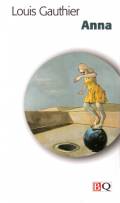Auteurs contemporains
Discours critique sur les œuvres de littérature contemporaine
Outils pour utilisateurs
Outils du site
Anna
 Louis Gauthier, Anna, Montréal, Cercle du livre de France, 1967.
Louis Gauthier, Anna, Montréal, Cercle du livre de France, 1967.
« “Ne m’attend pas. Je t’aime. Anna” Ce petit mot anodin trouvé un jour par le narrateur va servir de prétexte à un livre ludique où s’entrecroisent réflexions folles — et parfois plus graves —, jeux de mots, fantaisie et délire verbal qui font de ce roman une œuvre à part dans la littérature québécoise de son époque. En résumer l’action serait difficile puisqu’il ne s’y passe à peu près rien, sinon, dans l’imagination de celui qui attend Anna. Oscillant entre l’enthousiasme et le découragement, ce jeune narrateur explore mille et une formes de langage pour remplir les heures creuses qui le séparent du retour de celle qu’il aime. »
(Quatrième de couverture, BQ)
Documentation critique
LEDUC, Natali, « Divagation, prohibition of divagation and divagation of text », thèse de doctorat, Rice University, 2007, 199 f. +++ Thèse de doctorat / mémoire de maîtrise
###
Abstract
“Divagation”, which can be translated into English as wandering, rambling, ranting or even trespassing, is a literary “intergenre”, closely tied to a norm and an interdiction. As an “intergenre”, divagation appears in a variety of forms. We notice, however, a few recurrent elements: distance from the norm, movement and a special relationship with time and space. From the point of view of the norm, the subject of “divagation” can be perceived as a rival for the appropriation of a territory while from the point of view of the divagation, he might only be “passing by”. As he “divagues” in space, the subject reveals the rhizome nature of that space, in which all points are connected to one another and in which the subject can wander in infinite configurations. Freed from the past and the future, the subject of divagation wanders in the present and his movement becomes a presence. Divagation goes beyond the antagonistic view of the norm and even sometimes embraces “error” as one of its components. The subject of divagation, with his ambiguous nature and consciousness, finds himself “at home” in postmodernity. After 1960, the number of books that claim to be “divagations” raises considerably, which can be explained in part by a hasty interpretation of automatic writing, the vulgarization of psychoanalysis and a major change in the status of madness. After 1970, divagation is often perceived as a “rêverie” and is developped in poems with an emphasis on the “I”. Another interpretation of divagation, this one closer to biography, also appears in the blog. The ease of publishing texts on the internet, the absence of censorship and the absence of a reading panel play an important role in the process. Examples are taken from diverse works of divagation by Réjean Ducharme, Louis Gauthier, Marc Trillard, Stéphane Mallarmé and Benjamin Péret amongst others. Particular attention is given to surrealism and pataphysics, each of which has a different way of divagating.
Extrait de l’introduction, p. 4
« Une troisième coquille sera étudiée : le mélange de genres. Bien que très peu d’ouvrages dont le titre comporte le mot «divagation» optent pour le mélange de genres, il apparaît que ce type de genre est une coquille particulièrement propice à la divagation. Afin de montrer en quoi cette coquille se prête à la divagation, j’ai choisi d’utiliser La fille de Christophe Colomb de Réjean Ducharme et Anna de Louis Gauthier. Bien que le mot
«divagation» n’apparaisse pas dans leur titre, ces textes sont riches de divagation. Ils présentent deux types de mélanges de genres: une fusion et une juxtaposition ou accumulation. Dans la fusion, divers genres se font sentir du début à la fin de l’oeuvre, sans coupure nette. Dans le cas de La fille de Christophe Colomb, il y a fusion de l’épopée, du poème, du roman, de la parodie, du conte philosophique. Anna est plutôt une juxtaposition ou accumulation. Le récit est composé de courts textes relevant de genres différents. On peut généralement très bien distinguer les changements de genre au fil du texte. Dans Anna on retrouve des récits, pièce de théâtre, dissertations, concours, cartes postales, poèmes, chansons, dessins, recettes, discours, définitions de dictionnaire, listes, etc. Ce type de mélange de genres peut s’adapter au fil de l’écriture, ce qui est un avantage pour le sujet divagant qui erre sans but et qui est susceptible de changer de direction à tout moment. »
Leduc, 2007, PDF ###
IMBERT, Patrick, « Parodie et parodie au second degré dans le roman québécois moderne », Études littéraires, vol. 19, n° 1 (1986), p. 37-47. +++ Article de revue
### Abstract
Very often, intertextuality, in the Québec novels of the sixties and of the seventies, is not fully explored because it maintains a tendency towards the metalinguistic powers of parody. Thus, it is through a parody of parody, as performed by Jean-Marie Poupart and Louis Gauthier (rediscovering certain aspects of Joyce) that the questionning of the subject takes place and its corrolaries, absence of originality and disappearance of the origin and of its mythical powers.
| Anna (oeuvre) | |
|---|---|
| Titre | Anna |
| Auteur | Louis Gauthier |
| Parution | 1967 |
| Afficher | oui |